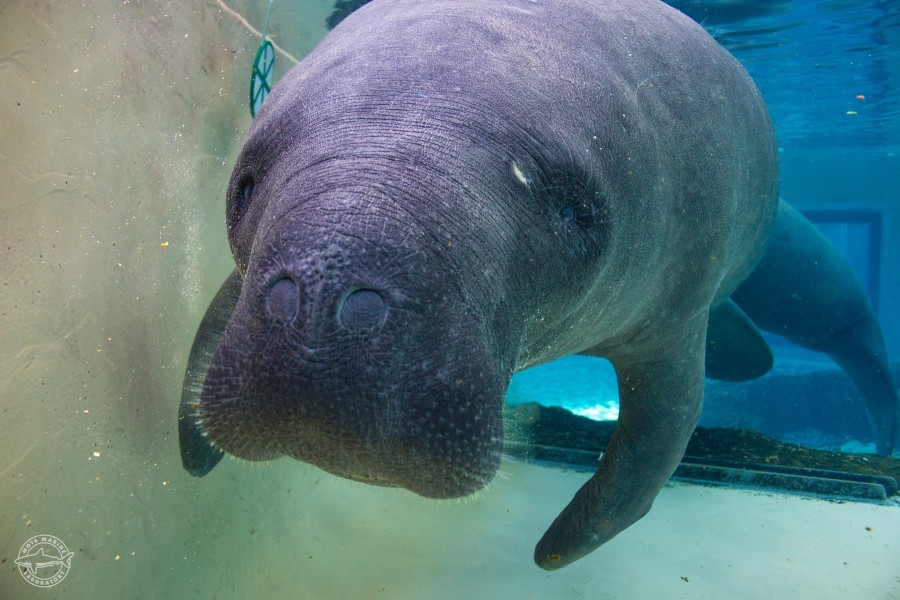Manatee temperature study could advance rehabilitative care
Media: The first interview opportunities with the study author are expected to be available during the week of April 2. However, media are welcome to share the content below starting March 28, Manatee Appreciation Day.
--
Detecting temperature changes in rescued and rehabilitated manatees — valuable information for manatee caregivers — just got easier thanks to a new method described in a research paper published online this month in the peer-reviewed Journal of Comparative Physiology B.
The paper was authored by a Mote Marine Laboratory scientist with co-authors from the University of Wales, Bangor; University of North Carolina, Wilmington, and the Florida Fish and Wildlife Conservation Commission’s (FWC’s) Fish and Wildlife Research Institute, with funding support from FWC.
Temperature changes can have major impacts on manatees’ health and survival. For example, during winter cold snaps, Florida manatees can sicken and die from cold stress syndrome if they cannot find warm-water refuges. Warm springs and other natural sites are critical refuges, but today, more than half of Florida’s manatees appear to use outflows from power plants and other industrial sources. Some natural and human-made refuges have vanished or changed over recent years, and some refuges may dwindle further as humans tap the aquifer that feeds springs and consider closing some aging power plants.
2018 started off unusually cold in Florida, and 52 manatees had died from cold stress by mid-March: already surpassing each of the past five years’ total cold-related mortalities. With similar impacts possible in the future, rehabilitators and resource managers seek a better understanding of manatees’ temperature regulation. Taking a manatee’s temperature orally is tricky and unreliable, as the thermometer may move around, and wild manatees tend to resist objects entering their mouths.
Instead, study authors investigated how to measure heat flux — heat moving between the body and environment — through “thermal windows”: body surface areas with the greatest potential for heat flux. The researchers turned to Mote’s resident manatees, Hugh and Buffett.
“Hugh and Buffett are the only manatees trained for this kind of research," to the best of Mote scientists' knowledge, said the study’s first author Dr. Nicola Erdsack, a Postdoctoral Research Fellow at Mote whose work is supported by the German Research Foundation (DFG). "With their participation we were able to conduct the first study of heat flux in Florida manatees."
Hugh and Buffett have been trained for husbandry and scientific experiments designed to benefit their species. Training allowed the authors to measure heat flux at 41 different sites on their bodies by pressing a custom-built heat flux transducer against the manatees’ skin while they were stationing in a nearly resting state. Similar heat flux measurements have been conducted in other marine mammals but never before in manatees. Data collection was led by Sophy McCully Phillips of the University of Wales under the supervision of a Mote senior scientist and manatee expert — the late Dr. John Reynolds.
Over six experimental sessions at different times of year, researchers found some body areas exchanged more heat with the environment than others.
“We were not surprised to find that a lot of heat flux was taking place in the fluke and the flippers,” said Erdsack, noting that these areas and the head are less insulated than the body’s trunk. Using these measurements and body surface area, the researchers calculated approximately how much heat each manatee lost, overall, to the cooler water.
“Each manatee had some variability in heat flux over time, but what really surprised us was the enormous difference between the two animals — Hugh’s average heat flux, was up to more than 100 percent greater than Buffett’s,” Erdsack said. “We expected Hugh to dissipate more heat because he is the smaller, ‘sporty’ manatee who moves around a lot, while Buffett is the less active, bigger one with more body fat. But we were surprised by how big the difference was. This allows conclusions about manatees in the wild — if they have too little fat, their risk of cold stress could be significantly greater.”
“We were also surprised to find that, despite constant water temperature, the manatees both had lower heat flux in winter — suggesting something was having a cooling effect on them,” said Erdsack. “This could mean the air temperature has a bigger impact on cold stress than previously realized.”
The authors also note that the manatees’ total heat flux, calculated across the entire body, can provide a useful indicator for their metabolic rate — which is very low relative to other mammals, particularly to other marine mammals — contributing to their cold-sensitivity.
How can manatee rescuers and rehabilitators apply these findings?
“From this work, we know which areas of the body can be used to measure heat flux over time,” Erdsack said. “A single measurement on its own won’t tell you a lot, but if you measure repeatedly and notice an increase or a decrease over time, you may be detecting cold stress or heat stress that should be addressed.”
Wild manatees are not trained like Hugh and Buffett, so medical exams usually require temporary restraints or even sedation — both of which will influence metabolism and heat flux, and must be taken into account.
Though researchers currently cannot take a wild manatee’s temperature in the environment, Erdsack is working to find a way.
“Manatees have to surface for breathing, and therefore the nostrils are the only parts periodically above the water,” Erdsack said. “I am trying to figure out if we can use the temperature in the nostrils as an indicator for body temperature, using an infrared thermometer. If this works, it would be a perfect tool for wild animals.”
